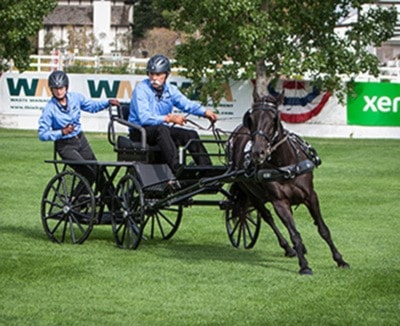In 1665 King Louis of France sent a shipment of two of his finest stallions and 20 mares to New France. On July 16, only 14 horses disembarked. Eight of the mares had perished on the journey.
More foundation stock was shipped and eventually a breeding program was established to increase Canadian horse herds in the colonies. The horses were rented out to leading farmers who bred and returned foals to the program as payment for the use of the animals.
The sturdy horses became famous for their strength, endurance and freedom from disease.
In the mid-1800s there were 150,000 Canadian horses spread across North America but eventually mass exportation became a problem.
The federal government became involved in trying to increase the population through a breeding program. In 1981 the effort ceased. The population of the breed afterwards was estimated at 400 and declared “critical.”
Private breeders and supporters stepped in and continue to help slowly increase the number, now estimated at 6,000 worldwide.
One of those private breeders is Elk River Candians, owned by Susan and Richard Arthur of Barriere B.C.
The Arthurs say, “We discovered the Canadian breed in 1991, shortly after moving to a rural area of Quebec. We had bought a little blue roan mare as a riding horse. We were told that she was a Canadian/Quarter Horse cross, but we didn’t have a clue what a Canadian horse was at that point. After having Tracey for a short time and noticing how different she was from the other horses, we started our research. It was a fascinating history we found, and we soon knew that we wanted to help preserve the breed for future generations. We bought Du Couteau Lalou Ellie, as an untrained two-year old, and brought both horses with us to B.C.
“Elk River Canadians started in Sparwood, B.C., when we lived near the Elk River at the edge of the Rocky Mountains.
“In the summer of 2004, we moved to Barriere, where we found more land and more opportunities to ride and drive. We have never become a big operation and recently we’ve decided to cut our Canadian breeding program even further so that we have more time to enjoy our horses.
“All of our Elk River horses have inherited the lovely movement and personalities of their parents. (Their sire is South Forty Prince Fonzie, owned by the Hillsdens in Cherry Creek, B.C.) Like most Canadians they are constantly “in your face,” checking out your work when you do fence repairs, following you around the paddock just in case you do something interesting, and mostly simply wanting your attention.
“They are quick learners...which isn’t always a plus, since they learn the bad just as quickly as the good things you teach them. That’s one reason a young Canadian doesn’t match well with a beginning horseman. Yet, a well-trained Canadian is a perfect find for young and old alike and will make a lovely addition to your family for many years to come.”
Due to the low numbers of the breed the Livestock Conservancy, an international watchdog for rare and endangered breeds, has just announced that the Canadian Horse’s status has changed from threatened to critical. The number of new foals being born and registered has dropped drastically over the past several years, and is now at the point where there will soon not be enough horses of breeding age to maintain the balance between births and deaths. The loss of this breed would be a tragedy, as it represents a living link to the past for Canada and all of North America.
This year marks the 350th anniversary of the Canadian horse landing in this nation, and Canadian horse enthusiasts around the country and the world (such as the Arthurs and Elk River Canadians) are celebrating a breed of horse that comes with a special mix of sturdiness, smarts and good disposition. They are also working very hard to inform the public about Canada's National Horse and the importance of the continuation of the breed.
As one of the first distinct horse breeds in North America, the Canadian Horse has contributed its genes to a number of other breeds, including the Morgan horse, the Tennessee Walking Horse, the American Saddlebred, and the Standardbred. Canadian Horses were exported to the US by the thousands as cavalry mounts, artillery horses and pack horses. They helped the Northern Armies win the American Civil War; those that survived the battlefield never came back to Canada. Across North America, they hauled logs and pulled plows, pulled stage coaches and sleighs, and carried cowboys and city folks alike. Eighteenth century historian Etienne Faillon described the Canadian as “small but robust, hocks of steel, thick mane floating in the wind, bright and lively eyes, pricking sensitive ears at the least noise, going along day or night with the same courage, wide awake beneath its harness, spirited, good, gentle, affectionate''. The same description can still be applied to the majority of Canadian Horses today.
Elk River Canadians say they will be promoting and exhibiting their Canadian horses this summer at:
• The Pacific National Exhibition in Vancouver which has dedicated Aug. 26 as Canadian Horse Day with riding, driving and historical demos held throughout the day.
• The North Thompson Fall Fair, where they will participate in the Sept. 5 parade, and then will have their horses on display on the fairgrounds from Sept 5 - 7.
The Arthurs say they support the views of CHHAPS, the Canadian Horse Heritage and Preservation Society. If people want more information on the horse, they can check out their website at www.chhaps.org or the FaceBook site https://www.facebook.com/pages/Canadian-Horse-Heritage-Preservation-Society
